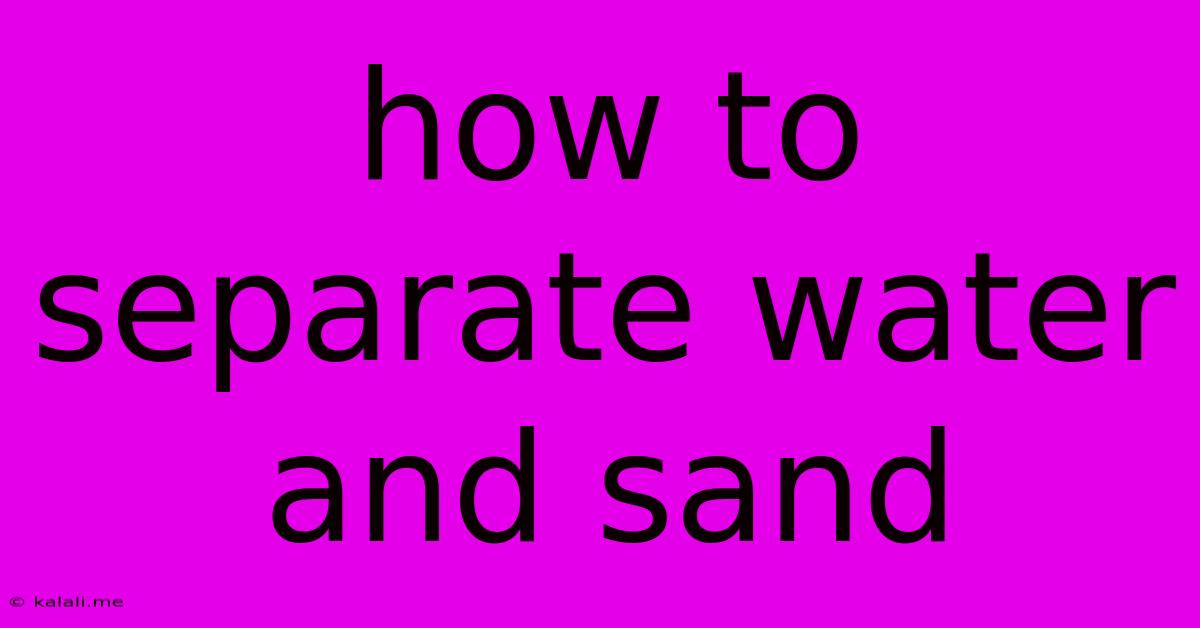How To Separate Water And Sand
Kalali
May 10, 2025 · 3 min read

Table of Contents
How to Separate Water and Sand: A Comprehensive Guide
Meta Description: Learn simple and effective methods for separating water and sand, from basic decantation to more advanced techniques. This guide covers everything you need to know, perfect for science projects or everyday situations.
Separating water and sand is a fundamental concept in science, particularly in chemistry and physical science. It's also a surprisingly useful skill to have in various everyday situations. This article explores several methods to achieve this separation, ranging from simple techniques suitable for home experiments to more advanced approaches.
Understanding the Principle
The separation relies on the difference in physical properties between water and sand. Water is a liquid, while sand consists of solid particles. This difference allows us to utilize methods that exploit these contrasting properties to effectively separate the two.
Simple Methods: Perfect for Beginners
These techniques are easy to understand and require minimal equipment, making them ideal for educational purposes or quick separations on a small scale.
-
Decantation: This is the simplest method. Carefully pour the water from the sand-water mixture into another container, leaving as much sand behind as possible. This method isn't perfect; some sand will likely remain in the water, but it's a great starting point.
-
Sedimentation: Allow the mixture to sit undisturbed for some time. The sand particles, being denser, will settle at the bottom, allowing you to carefully pour off the clearer water from the top. Combining sedimentation with decantation will yield better results.
-
Evaporation: This method takes longer but is very effective. Pour the mixture into a shallow, wide container and leave it in a sunny, warm place. The water will evaporate over time, leaving the sand behind. This is a good demonstration of the water cycle.
Advanced Techniques: Achieving Higher Purity
For situations requiring a purer separation, or for larger volumes of mixture, these methods are more suitable.
-
Filtration: This technique uses a filter medium (like filter paper or a cloth) to separate the solid sand from the liquid water. The mixture is poured through the filter; the water passes through, while the sand is trapped. This method is widely used in various scientific and industrial applications.
-
Centrifugation: This method uses centrifugal force to separate the sand from the water. A centrifuge spins the mixture at high speeds, forcing the denser sand particles to the bottom of the container. This is a more advanced technique requiring specialized equipment.
Choosing the Right Method
The best method for separating water and sand depends on several factors, including:
- The amount of mixture: For small quantities, decantation or sedimentation might suffice. Larger quantities may necessitate filtration or centrifugation.
- The desired purity: If high purity is needed, filtration or centrifugation are preferred.
- Available equipment: Simple methods require minimal equipment, while advanced techniques need specialized tools.
- Time constraints: Evaporation is time-consuming, while decantation or filtration are relatively quick.
Conclusion
Separating water and sand is a straightforward process with several effective methods. Understanding the underlying principles and selecting the appropriate technique based on your specific needs will ensure a successful separation. From simple home experiments to more complex scientific procedures, these methods provide valuable insights into the physical properties of matter.
Latest Posts
Latest Posts
-
How Many Quarts In A 5 Gallon Bucket
Jul 05, 2025
-
How Far Is The Closest Ocean Beach To Me
Jul 05, 2025
-
How Long Is A China Man Joke
Jul 05, 2025
-
What Episode Does Ichigo Get His Powers Back
Jul 05, 2025
-
Pokemon Mystery Dungeon Red Rescue Team Codes
Jul 05, 2025
Related Post
Thank you for visiting our website which covers about How To Separate Water And Sand . We hope the information provided has been useful to you. Feel free to contact us if you have any questions or need further assistance. See you next time and don't miss to bookmark.